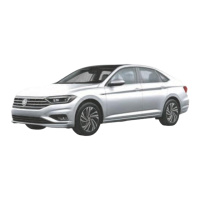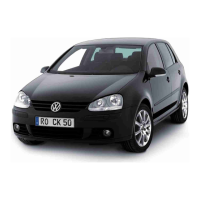If the rear seat backrest is folded down or raised
in an uncontrolled or inattentive manner, serious
injury could result.
•
When folding down the rear seat backrest,
always make sure that there are no persons or
animals in the backrest area.
•
Never fold or lift the rear seat backrest while
driving.
•
When raising the rear seat backrest, make
sure that the seat belt is not pinched or
damaged.
•
When folding and raising the rear seat backrest,
always keep hands, fingers, feet and other
parts of the body out of the area of the rear
seat backrest.
of its route.
•
In order for the rear seat belts to provide the
necessary protection, all parts of the rear seat
backrests shall be fitted with a safety belt.
must always be correctly fitted. This is
particularly important in the case of the centre
rear seat. If a person sits in a seat with a seat-
back which is not properly fitted, he or she will
be thrown forward together with the seat-back
in the event of braking, a sudden manoeuvre or
an accident.
•
If the backrest of the rear seat is folded down
or not properly engaged, do not allow anyone
to ride in the corresponding seats (even if the
seat is not properly secured).
a child).
Introduction to the topic
Raise the backrest of the rear seat
—
Lift the backrest and press it firmly into the lock
until it clicks → .
Headrest
If the rear seat backrest is folded down or raised in
an uncontrolled or inattentive manner, damage to
the vehicle and other objects may occur.
•
Before folding the rear seat backrest forward,
always adjust the front seats so that neither the
head restraints nor the backrest cushioning can
be folded forward.
of the rear backrest against them.
•
Before folding down the rear seat backrest,
always make sure that there are no objects in
the area of the backrest travel.
The following describes the adjustment options
and removal of the head restraints. Always make
sure that the seats are correctly adjusted → p. 36.
All seats are equipped with head restraints. The rear
centre head restraint (depending on equipment) is
only intended for the centre rear seat. Therefore, do
not mount it in any other seating position.
There are notches in the head restraint rods which
allow the head restraints to be fitted in various
positions. The head restraints can only fit correctly
into the notches in the adjustment area if they are
mounted correctly. To prevent inadvertent removal
of the head restraints after installation, there are
stops at the top and bottom of the adjustment
area.
Correct adjustment of the head restraint
Adjust the head restraint so that the top edge of
the head restraint is level with the top of the head,
but not below the eyes.
Always keep the back of the head as close as
possible to the head restraint.
Adjustment of the head restraint in the case of
short
persons
Lower the head restraint as far as it will go even if
the head is below the upper edge of the head
restraint. In the lowest position there may be a
small gap between the head restraint and the seat
back.
Adjustment of the head restraint in the case of
tall
persons
Raise the head restraint as far as it will go.
When driving with the head restraint removed
The use of an incorrectly adjusted or incorrectly
adjusted vehicle increases the risk of serious or
fatal injury in the event of sudden impacts,
braking and manoeuvring.
•
Always travel with the head restraint
mounted and correctly adjusted.
•
To reduce the risk of whiplash injury in the
event of an accident, all occupants of the
vehicle shall adjust the head restraint
correctly according to their height, taking
into account that the upper edge of it should
be
at the top of the head, but never below the
eyes. Keep the

